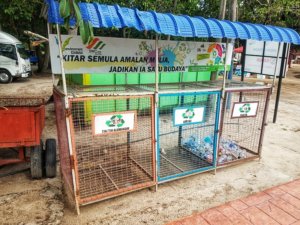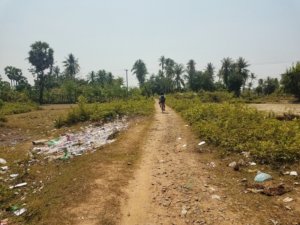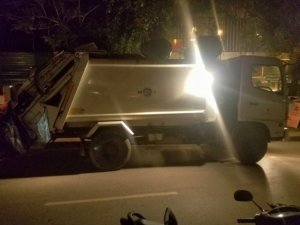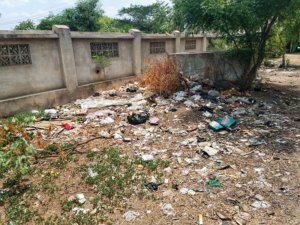It doesn’t take long for most visitors to Southeast Asia to notice the trash. For a region that is rich in culture, great food and natural beauty, it is disheartening to witness the piles of garbage around.

The problem with trash in Southeast Asia is that no one seems to care. From big cities to small villages, the problem is visible everywhere.
Contents
Trash & Tourism in Southeast Asia
Southeast Asia has become one of the world’s major tourist destinations. It’s cheap, exotic and adventurous for those of us hailing from quaint and calm corners of the western world.
As curiosity and a yearning for adventure grows, many of the countries – many of the governments – in Southeast Asia are getting rich off of tourist dollars. The influx of foreign cash has led to greater foreign investment, improvements in infrastructure, increases in GDP and lots of jobs. In some cases, countries that once sealed their borders have open doors and are allowing foreigners to visit. There has been an improvement in diplomatic relations, but the new visibility has also shed light on corruption and human rights violations.
According to the bottom line, tourism is a great benefit to Southeast Asia. If the governments of Southeast Asia want the gravy train to continue flowing, they need to clean up their act.
I’m not talking about corruption.. The governments of Southeast Asian countries need to establish basic ground rules on trash disposal.

On a small, pristine island in the Gulf of Thailand, I witnessed a simple act that shows the apathy in the local mindset. A local man was smoking a cigarette on a rickety pier used to unload goods and tourists. When he was finished with his breathing treatment, he flicked the cigarette butt right into the water. It was no accident. It was such a simple act, but I couldn’t understand it. This island is stunning, with postcard-perfect water and quiet beaches. Why ruin it?
No, a single cigarette butt is not going to sully paradise. What about thousands? Millions?
What about plastic bags, cans, straws, bottle caps and so on? All cast aside by millions of people who don’t care.
The man who flicked his cigarette butt to the sea is employed by tourism. He works with one of the ferries that goes to and from the island. Not that the people on this island aren’t great, but tourists are not coming here for the local charm. Tourists are also not traveling to this piece of paradise for the food. It’s alright, but it’s not worth the tedious journey for food that is just alright.
Tourists travel to these islands because of the natural beauty. Idyllic beaches, beautiful water, snorkeling, marine life and relaxation in tropical paradise are obvious reasons.
When these pieces of paradise are ruined, what then? Well, suddenly a lot of people will find unemployment and governments will quickly miss that extra chunk of tourist cash.
Travelers will simply go elsewhere. It’s already happening. No one wants to sit on a beach with a bunch of trash. Swimming and snorkeling is a lot less appealing when you’re dodging bits of plastic.
Bali is known for its natural beauty, but evidence below the surface reveals that parts of Bali have a serious trash problem. Phuket was once the destination for travelers to the Thai islands. Phuket is now a filthy place (in more ways than one) and more travelers are using it solely as a transportation point, quickly moving along to other, cleaner islands.
A few governments are choosing to intervene: Singapore is known for strict littering laws. The president of the Philippines closed Boracay to tourists for several months, as the island was overflowing with trash. Some Thai islands are now only open seasonally, to reduce traffic and preserve the natural environment. Occasionally, recycling containers make an appearance, although use is not prevalent.

These are necessary steps, but it is enough? Is it too late?
When an island closes, who hurts the most? It’s certainly not the tourists. They move on and find another island, another paradise. With the tourists gone, the locals will be the ones out of work. After an island closes and a reputation of pollution is established, the economic recovery time is unknown.
The Future of Trash in Southeast Asia
As I previously wrote about changing travel in Southeast Asia, trash and pollution has an impact on tourism.
If the lackadaisical attitude doesn’t change, Southeast Asia will become, like India, a land of trash. A lot of people are quick to blame tourism as a cause for trash. While an increase in tourism brings tens of thousands of people to fragile environments, the underlying reason goes far beyond a few extra people in town.

It’s easy to point at an island that is popular with foreigners, but what about the thousands of other dirty areas with no visiting foreigners? What about the major cities, cities like Bangkok, Hanoi, Yangon, that have millions of locals?
Tourists can do their part by not littering and searching for a trash can. Talking to locals and explaining the importance of proper waste disposal may help. But no one wants to be the tourist who goes around the world constantly pointing out cultural and governmental flaws to the locals. And if you are that person, you sound like a serious buzzkill.
The future of Southeast Asia is in the hands of governments and citizens. Citizens in Southeast Asia need to lobby and pressure governments to change the management of trash.

With success comes responsibility. And it is the responsibility of these governments to keep the streets clean to ensure future economic prosperity. This can be done by improving infrastructure further than new roads, high speed trains and luxury hotels. Improving infrastructure with waste removal and raising citizen awareness is a more efficient approach.
The responsibility lies with both governments and citizens of Southeast Asia to encourage improvements in trash removal and personal behavior.
Where I Stand
For starters, I want to clear up any possible confusion. I’m not on a mission, and I’m not an activist. I am observant and highly annoyed.
My preference of straws is metal, bamboo, plastic – anything but paper. I proudly drive a big American pickup truck. When I see palm oil plantations, I see jobs. Sometimes, I even use paper plates.
In my view, recycling is a good idea in theory. In practice, it’s a government racket. Seriously, local governments charge residents for recycling containers, charge for recycling pickup, then sell the collected recyclables to the highest bidder. And if the item is not perfectly clean, it goes to a landfill anyway. Excess plastic and waste is then shipped to a poor country halfway across the world.
Oh, and they tax bottles and everything else along the way. Why do we pay for this? How the hell is no one else talking about this scheme?
Recycling is a good idea when said aloud. It makes people feel like they’re making a difference, and governments get to pat themselves on the back. Unfortunately, recycling is not the solution. Mass populations are not going to make drastic changes unless there is a financial benefit. Instead, recycling costs citizens through every step of the process. Of course, if you brainwash them from an early age, there’s no need to fret over dissidence.
Recycling in its current state is is not going to solve the world’s pollution issue, and it is not going to make the trash in Southeast Asia disappear.
Clearly, I am not a tree-humping, environmentalist jackass. But, dammit, can’t people just throw away their trash?

Trash disposal is simple. The first step is proper disposal. In other words, finding a trash can. For developing nations, that step is having trash cans. Once the streets are clean and the garbage is collected in one location, then it’s time for a discussion on reusability and recycling.
My irritation has nothing to do with deformed turtles or whales suffocating on plastic bags. That sucks. It’s really terrible and wholly unnecessary. My reasons are concerning the continued economic stability for the people of Southeast Asia and, admittedly, selfish. Few sights are as irritating as a beautiful scene in nature ruined by heaps of garbage.

Dirty streets won’t keep me from traveling to unusual places. Travel to different, far away lands is exciting. I’m fairly certain the locals in those countries appreciate my money, too. For myself and other travelers, it might behoove those far away countries to consider proper trash removal before the situation is beyond control.
What Can We Do?
As travelers, we cannot clean up the world by ourselves, but we can make sure we don’t exacerbate the problem. And perhaps we can help, even just a little bit. Here are a few things you can do to help with the trash problem in Southeast Asia:
Pack a Small, Reusable Bag
When you need supplies, run to the supermarket or shop for souvenirs, bring your bag! Not only is this more resourceful, it is smarter. Plastic bags break, and using a good bag from home makes better sense.
As the western world turns in ire against the widespread use of plastic bags, most people in the world still don’t care. Take your eco-friendly practices from home with you abroad.
There’s no excuse to forget a good bag. It’s basic packing, and a canvas, burlap or any kind of sturdy, reusable bag easily fits in any backpack or suitcase. If every traveler to Southeast Asia cut out a dozen plastic bags on their trip, that just might clean up a beach or two.
Keep a Trash Bag on Hand
Eventually, even the most devoted tree-hugger will be given a plastic bag in Southeast Asia. Don’t immediately dismiss the use of a plastic bag. It will prove useful.
Trash cans and garbage bins are a rarity in Southeast Asia. You may go days without seeing a trash can in public. Buses rarely have a way to properly dispose of trash. Hang on to a plastic bag or two, and use it as a personal trash bag when there are none in sight.
Mind Your Butts!
Cigarette butts account for a considerable amount of litter across the planet. While smoking is decreasing in the west, that is not the case in most of Asia. In fact, smoking is incredibly cheap and prevalent in Southeast Asia.
Many travelers smoke more abroad, partly due to the cheapness. That’s fine, personal choices are personal. That doesn’t mean you have to throw every single cigarette butt on the ground. If only 10% of visitors to Southeast Asia smoke – the actual number is certainly higher, not including the millions of locals lighting up – that still amounts to hundreds of millions of cigarette butts.
Find an ashtray. In the middle of nowhere? Fine. Stomp it out and wait until you find a bin. It’s not hard.
Pack a Good Water Bottle
Don’t drink the water. Unless you find the idea of uncontrollable diarrhea appealing, don’t drink the water in Southeast Asia. That being said, bottled water is the norm in Southeast Asia and water bottles are everywhere.
Before heading to the region, bring a bottle with a filter. These are readily available online and in stores. Make sure it has a good filter that purifies water, eliminating bacteria and parasites.
If you forget the filtered bottle, buy a reusable bottle. Hotels and hostels often have clean water available to refill your bottle. You will save a few bucks on all those plastic bottles from the minimart and reduce your trash output at the same time.
Volunteer
If the desire to clean up your destination and make a difference is strong, you can! There are plenty of volunteer opportunities in Southeast Asia and elsewhere for travelers to donate time to clean up. Volunteering is rapidly growing as a way for tourists to have a more positive impact in their travels.
I can’t promise that I’ll be joining, but there are options for those who want to take eco-friendly travel a step further.
A single day volunteering to pick up trash won’t change the world. When thousands of tourists spend a day cleaning, they may see results and possibly encourage locals to join in the effort.
Spread the Word
Whether it’s through blogging, social media or simply telling friends, the best way to help combat heaps of trash when traveling is to inform others.
The governments of Southeast Asia, like most governments in popular tourist locales, are very sensitive to press that might negatively affect tourist revenues. If there is a problem, often times it will go untreated until it receives negative international attention. In other words, if the money is still coming in, who cares if there’s a little trash. Or human trafficking, drug use, oppression – you get the idea.
When more people raise awareness about the filthy state of a travel destination, action comes quicker. Complaining on social media may seem like a passive aggressive approach to dealing with trash in Southeast Asia, but governments notice.
With millions of tourists spending billions of dollars annually, the economy of Southeast Asia is dependent on tourist money. By raising awareness, packing an extra day bag, and making better choices, travelers can play an important part of keeping the region a little cleaner.
Currently, Southeast Asia is like most places in the midst of development – it’s dirty. That’s okay. Tourists don’t flock to this corner of the world in search of sparkling, shiny streets. However, there is a fine line where natural beauty and local charm is overtaken by trash. That’s not a good line to cross.

Governments can regulate pollution and attempt to control the environment as much as they like. Ultimately, change will not happen until individuals take charge and urge governments to act. When that happens, the future of the tourist economy will strengthen and, most importantly, local quality of life will improve.
Hopefully, Southeast Asia will soon get a hold of this growing problem with trash.
I haven been preaching the same for 55 years. The same people live in “their communities” in other parts of the world and bring that like style with them. Most of India, Pakistan, and Bangladesh are not tourist areas and have never seen tourists but also don’t see the mounts of rubbish that is strewn everywhere. A significant number of smokers world-wide don’t care where their “butts” go. You say something to a smoker flinging the but, you become the evil one and get smoke blown in your face.